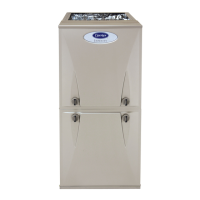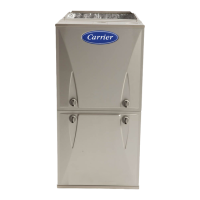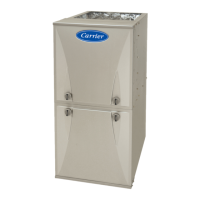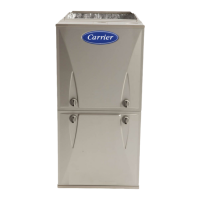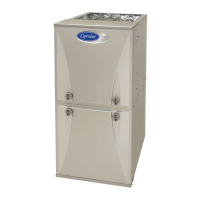94
The start up and shut down functions and delays described above
apply to the 2-stage minimum/maximum heating mode as well,
except for switching from maximum- to minimum-heat.
1. Switching from Maximum- to Minimum-Heat —Ifthe
thermostat R to W2 circuit opens, and the R to W1 circuit
remains closed, the furnace control CPU will gradually de-
crease the inducer motor speed to the required intermedi-
ate-heat RPM. When the inducer motor IDM reduces pres-
sure sufficiently, the high pressure switch HPS will open
and the gas rate will be changed to intermediate-heat. The
gas valve solenoid GV (pin 5) will remain energized as
long as the low pressure switch LPS remains closed. When
the inducer motor speed gets within 15% of the required
intermediate-heat RPM the furnace control CPU will start a
5 second blower airflow change delay. After the 5 seco nd
blower airflow change delay is completed the blower air-
flow will transition to minimum-heat airflow. At this point
the furnace control CPU will energize the PSR relay to
open the NC contact and slowly decrease the inducer motor
speed to th e req uired min im u m -heat R P M . W h en th e
PSR relay is energized and the NC contact opens the fur-
nace control CPU will reduce the gas rate to minimum-heat
RPM.
Two-Stage Therm ostat and Two-Stage Intermediate/
Maximum Heating
See Fig. 36 and 38 for thermostat connections
NOTE: In this mode the intermediate-heat only switch SW4-2
must be ON to select the intermediate-heat only operation mode in
response to closing the thermostat R to W1 circuit. Closing the
thermostat R to W1-and-W2 circuits always causes
maximum-heat operation, regardless of the setting of the
intermediate-heat only switch.
The wall thermostat ”calls for heat”, closing the R to W1 circuit
for intermediate-heat or closing the R to W1-and-W2 circuits
for maximum-heat. The furnace control performs a self-check, and
verifies the low, medium and high pressure switch contacts LPS,
MPS and HPS are open , then de-energizes the PSR relay to close
the NC contact.
The start up and shut down functions and delays described above
apply to the two-stage intermediate/maximum heating mode as
well, except for switching from maximum- to intermediate-heat.
1. S w itch in g from Ma x im u m - to Interm ed iate-Hea t —
If the thermostat R to W2 circuit opens, and the R to W1
circuit remains closed, the furnace control CPU will gradu-
ally decrease the in d u cer moto r sp eed to the requ i red in-
termediate-heat RPM. When the inducer motor IDM re-
duces pressure sufficiently, the high pressure switch HPS
will open and the gas rate will be changed to intermedi-
ate-heat. When the inducer motor speed gets within 15% of
the required intermediate-heat RPM the furnace control
CPU will start a 5 second blower airflow change delay. Af-
ter the 5 second blower airflow change delay is complet-
ed the blower airflow will transition to intermediate-heat
airflow.
Cooling Mode
The thermostat “calls for cooling.”
1. Single-Speed Cooling
See Fig. 36 and 38 for thermostat connections.
The thermostat closes the R to G-and-Y circuits. The R to Y circuit
starts the outdoor unit, and the R to G-and-Y/Y2 circuits start the
furnace blower motor BLWM on cooling airflow. Cooling airflow
isbasedontheA/CselectionshowninFig.65.
The electronic air cleaner terminal EAC-1 is energized with 115
vac when the blower motor BLWM is operating. When the
thermostat is satisfied, the R to G-and-Y circuits are opened. The
outdoor unit will stop, and the furnace blower motor BLWM will
continue operating at cooling airflow for an additional 90 seconds.
Jumper Y/Y2 to DHUM to reduce the cooling o ff-delay to 5
seconds. See Fig. 36.
2. Single-Stage Thermostat and Two-Speed Cooling
(Adaptive Mode)
See Fig. 36 and 38 for thermostat connections.
This furnace can operate a two-speed cooling unit with a
single-stage thermostat because the furnace control CPU includes a
programmed adaptive sequence of controlled op erat ion , which
selects low-cooling or high-cooling operation. This selection is
based upon the stored history of the length of previous cooling
period of the single-stage thermostat.
NOTE: The air conditioning relay disable jumper ACRDJ must be
connected to enable the adaptive cooling mode in response to a
call for cooling. See Fig. 36. When in place the furnace control
CPU can turn on the air conditioning relay ACR to ener gize the
Y/Y2 terminal and switch the outdoor unit to high-cooling.
The furnace control CPU can start up the cooling unit in either
low- or high-cooling. If starting up in low-cooling, the furnace
control CPU determines the low-cooling on-time (from 0 to 20
minutes) which is permitted before switching to high-cooling.
If the power is interrupted, the stored history is erased and the
furnace control CPU will select low-cooling for up to 20 minutes
and then energize the air conditioning relay ACR to energize the
Y/Y2 terminal and switch the outdoor unit to high-cooling, as
long as the thermostat continues to call for cooling. Subsequent
selection is based on stored history of the thermostat cycle times.
The wall thermostat “calls for cooling”, closing the R to G and- Y
circuits. The R to Y1 circuit starts the outdoor unit on low-cooling
speed, and the R to G-and-Y1 circuits starts the furnace blower
motor BLWM at low-cooling airflow which is the SW3 selection
as shown in Fig. 65.
If the furnace control CPU switches from low-cooling to high
cooling, the furnace control CPU will energize the air conditioning
relay ACR. When the air conditioning relay ACR is energized the
R to Y1-and-Y2 circuits switch the outdoor unit to high-cooling
speed, and the R to G-and-Y1- and-Y/Y2 circuits transition the
furnace blower motor BLWM to high-cooling airflow.
High-cooling airflow is based on the A/C selection shown in Fig.
65.
NOTE: When transitioning from low-cooling to high-cooling the
outdoor unit compressor will shut down for 1 minute while the
furnace blower motor BLWM transitions to run at high-cooling
airflow.
The electronic air cleaner terminal EAC-1 is energized with 115
vac whenever the blower motor BLWM is operating.
When the thermostat is satisfied, the R to G-and-Y circuit are
opened. The outdoor unit stops, and the furnace blower BLWM
and electronic air cleaner terminal EAC-1 will remain ener gized
for an additional 90 seconds. Jumper Y1 to DHUM to reduce the
cooling off-delay to 5 seconds. See Fig. 36.
3. Two Stage Thermostat and Two-Speed Cooling
See Fig. 36 and 38 for thermostat connections.
NOTE: The air conditioning relay disable jumper ACRDJ must
be disconnected to allow thermostat control of the outdoor unit
staging. See Fig. 36.
The thermostat closes the R to G-and-Y1 circuits for low cooling
or closes the R to G-and-Y1-and-Y2 circuits for high cooling. The
R to Y1 circuit starts the outdoor unit on low cooling speed, and
the R to G-and-Y1 circuit starts the furnace blower motor BLWM
at low-cooling airflow which is the SW3 selection as shown in
Fig. 65. The R to Y1-and-Y2 circuits start the outdoor unit on
high-cooling speed, and the R to G-and-Y/Y2 circuits start the

